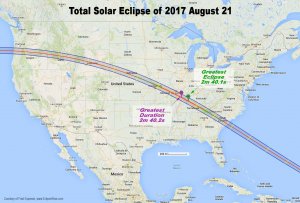By now you have probably heard tons of people (us included) talk about the solar eclipse. You know that you have to buy special glasses to see it. You also probably know that it will happen on August 21st and it’s a more rare event to be a part of.
But beyond those basic facts, what really makes a solar eclipse so special and what do you need to do to make the most of it? Let’s start off by taking a much deeper look at what makes this solar eclipse so special.
What it is a solar eclipse?
The first thing to understand about a solar eclipse is what it is. A solar eclipse is when the moon moves directly in front of the sun and covers it completely for a very short period of time. The temperature drops, animals get confused, and a beautiful panoramic view of a sunset appears.
Day turns into night and complete darkness eliminates the light depending on if you’re experiencing an annular or total eclipse. An annular eclipse occurs when the moon covers most of the sun. A total eclipse covers the entire sun for zero to almost three minutes.

Annular eclipses are few in number and even fewer actually hit each continent over the course of several decades. Total eclipses happen even less often and are much more special.
In order to see the total eclipse that is happening this August, you’ll need to be in the totality plain or you won’t see it. The totality plain is a narrow 70 miles stretch that starts in Oregon and goes across the country to South Carolina. It gets even crazier. To see the maximum amount of the eclipse as possible you need to get to the center of the 70 miles plain. Very few cities are in line so you’ll want to see which city is nearest you and get there.
How To Get The Most Out Of The Eclipse
Even if you are in the the central path of totality, you won’t get the most out of the eclipse unless you know what will happen and when. Experts break the eclipse into four stages: C1,C2, C3, C4 or also known as contact times.
- C1 is the time when the linear disk from the moon touches the solar disc of the sun in the sky. The moon then moves across the sun over the course of about an hour.
- C2 is the exact time when the linear disk covers the sun.
- C3 is the moment when the disk starts moving away from the sun. This process also takes about an hour in the opposite direction.
- C4 is the exact moment when the moon stops covering the sun.
Experts say you won’t want to miss these four stages with all of the other events happening beforehand. These events include temperature drops, animals getting confused by the unexpected nightfall, and a strange phenomenon called shadow bands, which look like snake shadows on the ground.
Plastic surgeon Gordon M. Telepun has spent some time developing an app called Solar Eclipse Timer. The app outlines each of these four stages and the exact contact times of when each stage begins for your location. To get the most out of the eclipse, definitely get this app. To learn even more about it, watch the Smarter Every Day video.
